
Creating a strong bartender resume is the first and most critical step toward getting a job as a bartender.
Your bartending resume is a reflection of yourself and your talents. It is intended to offer your potential employer a good picture of what you would be like if they hired you.
Put in the time and effort to create a grammatically correct, professional-looking resume. Showcase your greatest qualities, abilities, and/or experience as a bartender. If you have extensive experience but no postsecondary education, simply leave the education area blank.
And vice versa: if you have a bartending degree, a mixology certificate, and a draught master certification but no real experience, prioritize these elements on your bartender CV.
Tips for Crafting a Successful Bartender Resume
While some of these should come as common knowledge, let’s still list them:
- Never lie on your bartending CV. Chances are, the potential employer will find out, and you’ll be fired.
- Always use the spell checker and read it aloud to ensure that it sounds fine and that everything is correct.
- Read it aloud to several different people. The more people you read it to, the more various perspectives and useful comments you’ll receive.
- Make sure it has a polished design. This is your one chance to impress before earning the bar interview.
- Stand out from the crowd. Bars and nightclubs receive so many resumes that it is nearly impossible to recall who dropped them off. Make your bartender CV unique, and you’ll stand out from the crowd.
If your bartender CV isn’t impressive, you won’t get the chance to shine and sell yourself at the bar interview.
Creating a Bartender Resume Structure That Would Appeal to Recruiters
Your bartender’s resume will be evaluated based on a few aspects, one of which is how it is presented.
Is your resume readable and organized? Does it have a smooth flow?
Or have you sent recruiters a disorganized paper that lists everything you’ve ever done in your career?
Unless otherwise noted, there are four best practices for ensuring uniformity in your resume.
The top one-third of your resume should undoubtedly have a headline so that recruiters can simply contact you and see your professional portfolio.
Within the experience section, include your most recent (and relevant) position first, followed by the rest of your work history in reverse chronological order.
Always send your resume as a PDF file to ensure that it retains its formatting.
Your bartender resume can be two pages if you are going for a more senior position and have over ten years of relevant job experience, which will impress recruiters. Otherwise, your resume should be no longer than one page.
Five Tips for Creating a Bartender Resume Experience Section
The ideal way to approach the experience area of your bartending resume strategically is to include evidence of accomplishments and activities that relate to your specific duties.
For instance, you may list:
- Up to six day-to-day tasks, supported by why they’re essential for your career, department, or company.
- Experience you gained that has helped you expand your technical knowledge within the industry, or that has helped you grow as a professional;
- Any metrics that highlight your accomplishment in previous employment;
- How have you overcome certain challenges in your day-to-day work?
- Growth strategies and solutions you’ve employed, as well as how that growth has been quantified.
The bartender resume experience is your best chance of generating a positive first impression on recruiters. That is why you should check some real-world bartender resume examples to get a better insight into how to display your experience.
What Can Applicants Do with Their CV, if They Have No Experience?
Other sections in your bartender CV may be able to address job criteria.
As a result, you’d be replacing your lack of experience with your relevant:
- Education, including facts about the abilities you’ve acquired that are relevant to the position.
- Internships and temporary positions that will once again highlight your abilities.
- The Skills section addresses fundamental and, perhaps, more specific employment requirements.
Even if you have little or no professional experience in the business, use your strengths or successes to demonstrate your unique worth.
Take Your Bartender Resume to the Next Level with These Extra Resume Sections
Your bartender resume might include a wide range of talents. Choose those that best fit the job criteria and demonstrate your compatibility with the corporate culture.
You could also put in all the languages you speak. It’s a good idea to list any languages you are competent in as well as your degree of expertise. This displays your dedication to communication.
You can also list up to three projects you’ve worked on outside of work to showcase your growth both as a person and as an employee. Include a link to your project portfolio in the bartender resume headline, if relevant.
And lastly, you could describe the topics you are passionate about, the positions you have performed, and your voluntary successes. Such experiences are likely to have developed a variety of soft skills required for your ideal career.
Conclusion
Bartending resumes should be about getting the attention of your potential employers, as a chance to have a face-to-face meeting where you can impress them. Making sure your resume is polished, looking professional, and containing all the relevant information is a way to ensure you stand out from the crowd.
Good luck in job hunting!



